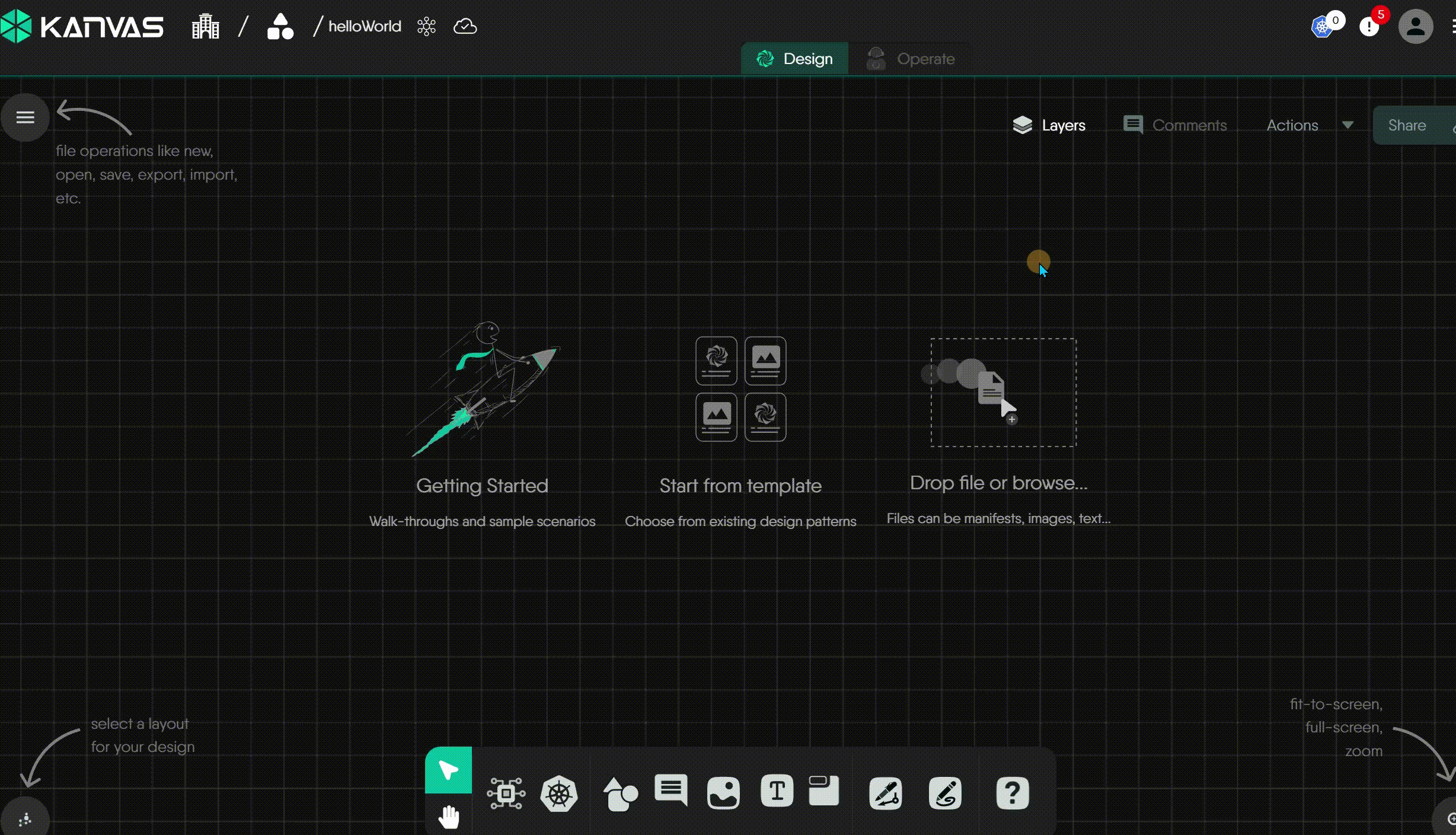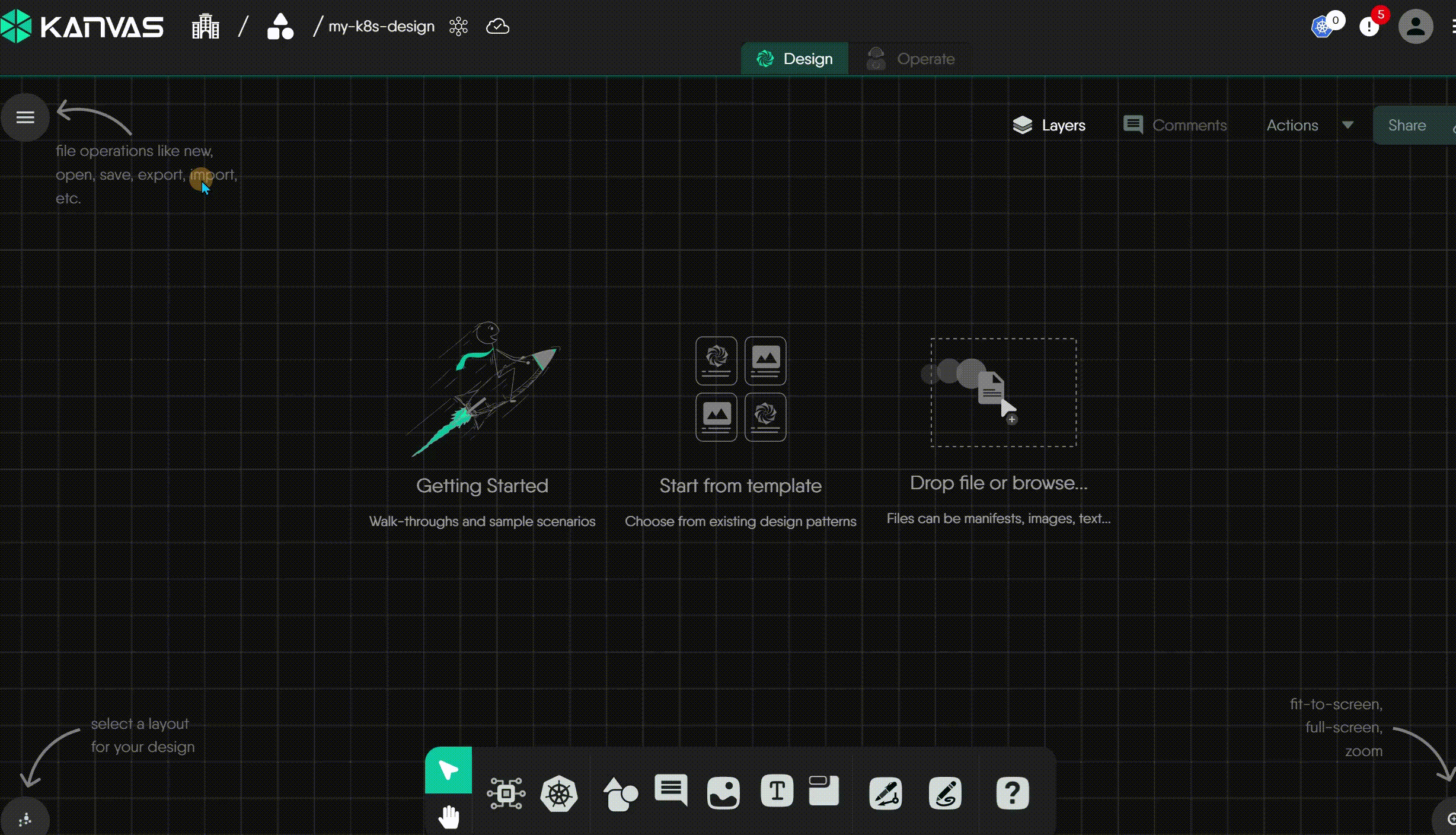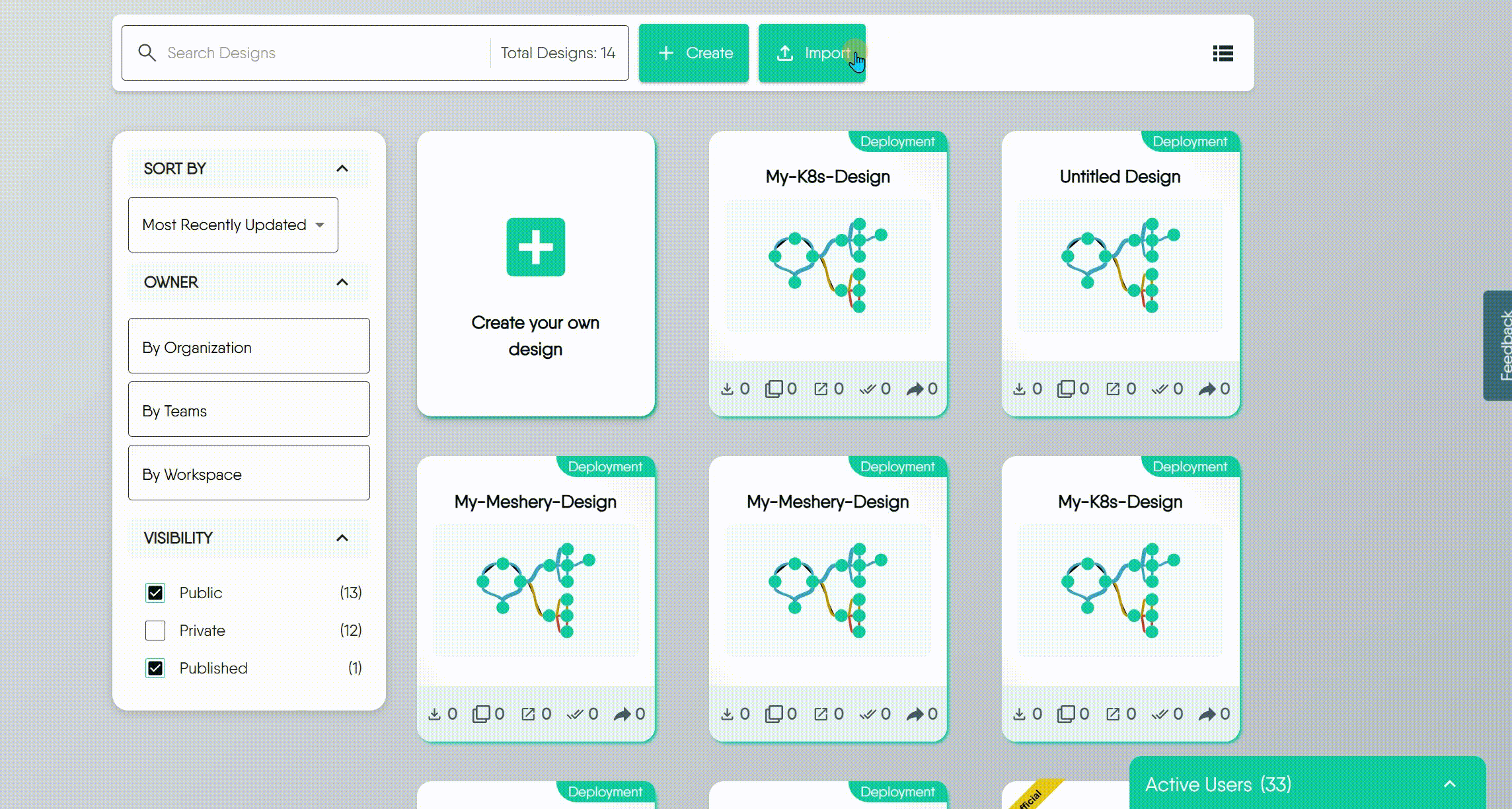Importing a Design
Categories:
Kanvas acts as a powerful bridge, enabling you to import your existing application and infrastructure configurations from a wide variety of standard formats. It transforms these configurations into visual, editable, deployable, and shareable designs. This guide covers how to import designs, the supported formats, and important considerations.
Accessing the Import Functionality 🔗
There are multiple ways to import a design.
You can drag a file from your local computer directly onto the Kanvas canvas to import a design.

The most direct method is to click the hamburger menu (☰) in the top-left corner, then select the “Import” button in the Kanvas toolbar.

Navigate to the My Designs page and click the “Import” button.

For a more advanced, repository-based workflow, you can establish a persistent connection between your GitHub account and Meshery. This allows you to browse your repositories and import multiple designs directly.
Learn more about GitHub integration.
Recommendation: Use Kanvas Import
For the most flexibility, we recommend initiating the import from within Kanvas. This interface gives you the option to either import the configuration as a brand-new design or merge it into a design you currently have open.Importing by Infrastructure Type 🔗
Kanvas supports a diverse set of infrastructure types and packaging formats. The following sections provide detailed requirements and instructions for each.
Cannot Import Folders Directly
You can’t directly import folders. If your infrastructure definition (like Kustomize or Helm) is in a folder, you must compress it into a single archive file before uploading.Importing from a Kubernetes manifest is the most direct way to bring your existing configurations into Kanvas. This method is suitable for any standard .yaml or .yml file that conforms to the Kubernetes API specification, as well as for projects managed by Kustomize.
1. Importing Plain Kubernetes Manifests: If you have Kubernetes configurations available as standard manifest files, you can import them directly.
- Supported Packaging Formats: A standard
.yamlor.ymlfile containing one or more Kubernetes resource definitions.
2. Importing a Kustomize Project: If you manage your Kubernetes configurations with Kustomize, a popular template-free tool for customization, you can import your entire project.
A key requirement when importing a Kustomize project is that you must provide the entire project directory, not just the kustomization.yaml file. This is because the kustomization.yaml file only contains instructions and references to other base manifest files. To correctly render the final configuration, Kanvas needs access to all of these related files.
- Supported Packaging Formats: A archive (such as
.zip,.tar, or.tar.gz) containing the complete Kustomize project directory. This archive must include thekustomization.yamlfile and all of its referenced resources.
Helm is the standard package manager for Kubernetes. Importing a Helm chart into Kanvas allows you to visualize, manage, and customize complex applications. To ensure a successful import, you must provide the complete packaged chart. Importing individual chart files like Chart.yaml or values.yaml is not supported.
- Supported Packaging Formats:
- Chart Archive (
.tgz,.tar, or.tar.gz): The standard gzipped tarball format for distributing Helm charts. - OCI Artifact: A modern packaging standard. When exported as a file for upload, this can be imported via an
oci://URI from a container registry.
- Chart Archive (
This import method provides a convenient bridge for developers looking to migrate their applications from a local Docker-based environment to Kubernetes. Kanvas will parse your docker-compose.yaml file and automatically translate your services into their equivalent Kubernetes resources.
- Supported Packaging Formats: A standard
.yamlor.ymlfile. For best compatibility, ensure your Compose file includes aversionkey (e.g.,version: '3.8') at the top level.
This is Meshery’s native format and provides a lossless way to save and import your designs. It preserves all of an application’s component configurations as well as the visual layout, annotations, and metadata from the Kanvas designer.
- Supported Packaging Formats:
- YAML File (
.yml): The standard, human-readable file generated when you export a design. - OCI Artifact: Meshery Designs can also be packaged as OCI artifacts, allowing them to be versioned and distributed via container registries.
- YAML File (
Frequently Asked Questions 🔗
What happens if I drag and drop multiple files onto Kanvas at once? 🔗
Each supported file will be imported as a separate, new design. For example, if you drag three different Kubernetes manifest files onto Kanvas, three distinct designs will be created.
What happens if I select multiple files in the File Upload dialog? 🔗
The “File Upload” dialog is designed to process one file or package at a time. If you select multiple files in your operating system’s file browser, only the last file in the selection will be processed for import. To import from multiple files, please import them individually.
After importing a file, can I download my original, unaltered file? 🔗
No. When a file is imported, it is converted into a native Meshery Design. The original source file is not stored and cannot be downloaded later. The export function will generate a new file based on the current state of your design.
For more details, see the Exporting Designs guide.
When I import from a Kubernetes manifest, Helm chart, or other type, and choose to merge this file into an existing design, can I download my original file? 🔗
When you choose to merge a new design into an existing one, Meshery first creates a separate design from your imported file before performing the merge. You can find this newly created design on your My Designs page.
Are there any differences, limitations, or special requirements for importing via File Upload, URL, or the GitHub Integration? 🔗
Yes. File Upload and URL Import are simple, one-time actions for importing a single design. In contrast, the GitHub Integration creates a deep, persistent connection to your GitHub account.
It requires you to authorize the Meshery GitHub App, which then allows you to browse your repositories and select designs directly from the Meshery UI. Most importantly, this integration can enable a GitOps workflow by adding a GitHub Action to your repository that provides visual snapshots of design changes in your pull requests.
Is there a file size limit for imported designs? 🔗
There is no strict limit on the file size itself (e.g., in MB). However, there are limits on the number of components a design can contain, which is determined by your current subscription plan. Free accounts are limited to 100 components.
If you attempt to import a design that contains more components than your plan allows, the import will fail with a message stating that the component limit has been exceeded.
Learn more about plans.
Recent Discussions on Kanvas
- Jul 12 | Unleash Visual Power: Import Your Configs by zihan kuang
- Oct 14 | Explore Meshery's Published Relationship Design Examples by Awani Alero
- Oct 03 | Design Review RFC: Kanvas Empty State Enhancement by Lee Calcote
- Jul 19 | [For Discussion] Visual indication of semantically vs non-semantically meaningful Meshery components by Lee Calcote
- Jun 07 | What are the conditions for a "System is unhealthy" warning? by James
- May 30 | Looking for a meshmate to help with first PR by Faisal Imtiyaz123
- Feb 28 | For Discussion: Capturing potential, but unrealized Relationships in Design Snapshots by Lee Calcote
- Feb 12 | Hint on Scaling & Verifying Cronjob in Playground by Sandra Ashipala




